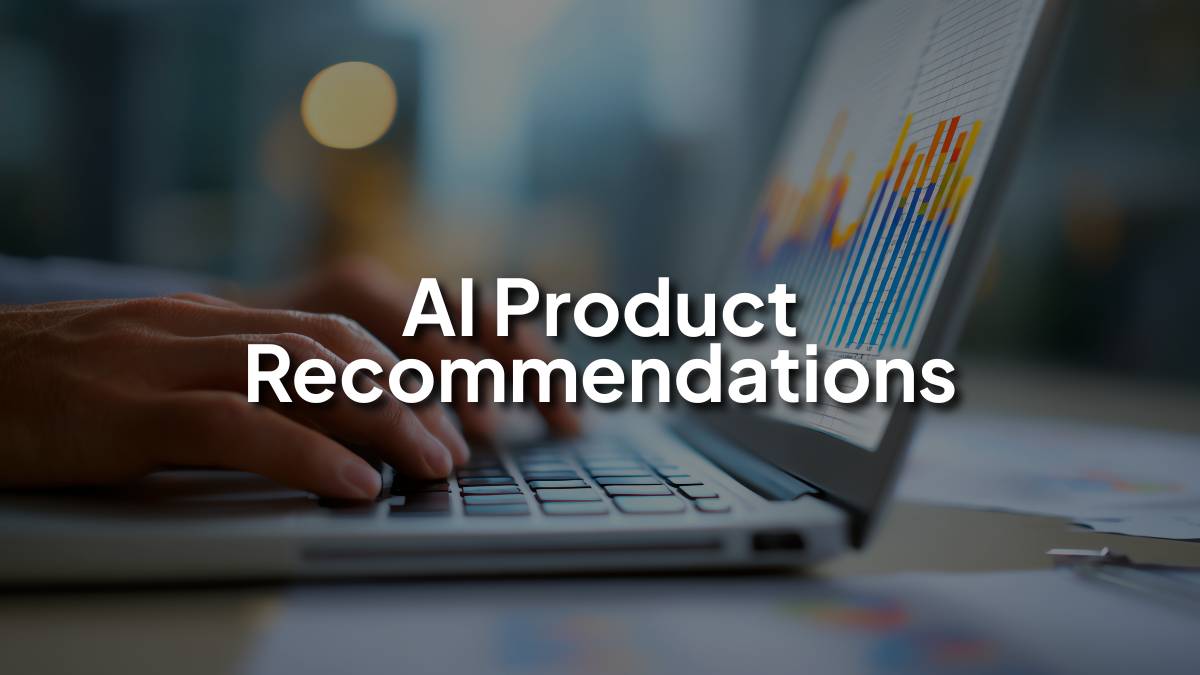Table of Contents
Introduction
AI product recommendations have quietly become one of the biggest drivers of online sales. Basically, they’re suggestions that a user is likely to click on or buy, based on patterns in data. It’s not magic. It’s math and observation, constantly learning from how people interact with products.
For businesses in 2025, the stakes are higher than ever:
- Customers expect shopping to feel personal. Generic lists don’t cut it anymore.
- Personalized recommendations lead to better conversions. More people end up buying because they see what actually interests them.
- Engagement improves. People spend more time exploring relevant products.
The tools behind this? Algorithms, recommendation engines, and platforms that can process tons of data quickly. They figure out what a person might want before they even know it themselves.
What Are AI Product Recommendations?
At the simplest level, AI product recommendations suggest products to users based on what they’ve done before, what similar users liked, and sometimes even what’s trending. It’s all about relevance.
How these recommendations work in practice:
- Collaborative filtering: Looks at what other people like. If users with similar behavior bought something, it might be suggested to you.
- Content-based filtering: Focuses on the product itself. Features, categories, attributes: if a user liked something with these traits, similar products get recommended.
- Hybrid models: Mix both approaches. More data, better suggestions.
Why businesses care:
- Can boost sales and average order value. People see things they actually want.
- Keeps users engaged. They feel like the platform “gets them.”
- Improves retention. A personalized touch makes people come back.
Real-world examples:
- Amazon is a classic example. Recommendations show up everywhere: homepage, checkout, emails. They’re everywhere, yet feel personal.
- Netflix: Suggests shows and movies based on viewing patterns and what other users with similar tastes enjoyed.
- Shopify apps: Give smaller merchants plug-and-play recommendation features without heavy tech setups.
How AI Product Recommendations Work
The “how” behind recommendations is really where the magic, or frustration, happens. It’s not complicated to explain, but it’s easy to overthink.
Algorithms powering recommendations:
- Machine learning: Learns from what people did before. Simple patterns first, complex ones later.
- Deep learning: Can pick up subtle habits, like “this user likes products with X and Y together.”
- Reinforcement learning: Keeps adjusting. If a suggestion doesn’t get clicked, it tries something else next time.
Data that drives recommendations:
- User behavior: clicks, searches, wishlist additions, cart actions, purchases.
- Demographics: age, location, language.
- Ratings and reviews: what users say about products.
- Search queries: signals of intent.
Timing matters:
- Real-time recommendations: Update instantly while someone browses.
- Batch recommendations: Updated periodically based on accumulated data.
Frameworks that make it work:
- TensorFlow Recommenders: Flexible for experimentation.
- Microsoft Recommenders: Enterprise-ready solutions.
- Amazon Personalize: Real-time, scalable, widely used.
The key takeaway? It’s all about connecting the right product to the right person at the right time. Done well, it feels seamless. Done poorly, it feels random.

Apply Now: AI Marketing Course
How to Make AI Recommend Your Product
Getting your product recommended isn’t a one-time thing. It’s not luck. It’s a process. Good data, watching what users do, and using the right tools, those three things matter most. Even small tweaks can make recommendations hit or miss.
1. Optimize Product Data for AI Systems
- Keep data structured: Titles, descriptions, categories, tags, SKUs, everything neat. Messy catalogs confuse the system.
- Add visuals: Images, videos, maybe even 3D views. Helps the system “see” products, not just read text.
- Name things consistently: Clear names, proper categories. Makes reading easier for the system.
Sometimes, tiny details make the difference between a product being suggested or ignored.
2. Collect High-Quality User Data
- Track clicks, searches, cart adds, wishlist items, and purchases. Every action counts.
- Tools like Hotjar, Mixpanel,and GA4 can help see patterns.
- Privacy matters. GDPR and CCPA rules aren’t optional. Users notice when data is respected.
Even partial tracking can help. Better tracking gives smarter suggestions.
3. Use Recommendation Tools
- Amazon Personalize: Works for large catalogs, scales well.
- Algolia Recommend: Fast, good for e-commerce.
- Dynamic Yield: Handles multiple channels.
- Salesforce Einstein: Connects to CRM data.
- Shopify apps: Simple plug-and-play for small stores.
Pick what fits your setup. Don’t overcomplicate. Sometimes simpler works better.
4. Implement Recommendation Strategies
- Collaborative vs content-based filtering: Collaborative looks at what users like, content-based looks at product features. Use both if possible.
- Hybrid models: Combine both. More accurate suggestions.
- Test everything: A/B testing helps see what works.
- Upsell & cross-sell: Suggest related products. Keep it helpful. Not pushy.
Even small strategy changes can shift results.
5. Monitor & Improve Performance
- Watch metrics: CTR, conversion rate, average order value, and retention. Little changes matter.
- Keep models fresh: Data changes, trends change. Retrain often.
- Segment users: Not everyone responds the same. Tailor recommendations.
Recommendations aren’t static. They change as users interact more. Regular tweaks make them more effective.
Also Read: Brand Visibility in AI Tools
Benefits of AI Product Recommendations for Businesses
AI product recommendations do more than push products. They quietly change how people shop and how businesses operate.
- Increase sales and revenue: When a person sees something relevant, they’re more likely to click. And if they click, they often buy. It’s that simple.
- Better customer experience and loyalty: Recommendations that actually make sense make users feel understood. They notice. They return.
- Lower churn and cart abandonment: Smart suggestions can remind users of what they wanted or liked. Sometimes that nudge is enough to finish the purchase.
- Smarter inventory management: Recommendations show trends, help with stock planning, and reduce wasted inventory. Less guessing. Less stress.
Even small tweaks can make a noticeable difference. It’s not about huge changes. Little improvements add up fast.
Also Read: What is an LLM and how does it work?
Common Challenges in AI Product Recommendations
It’s not all smooth. There are bumps along the way.
- Cold start problem: New users or new products don’t have data. Recommendations can feel random or off. It takes time to learn.
- Data privacy and ethics: Handling user data the right way is critical. Get it wrong, and trust disappears fast. Legal issues can come too.
- Algorithm bias and wrong suggestions: Sometimes the system pushes irrelevant or even biased recommendations. That annoys people.
- Integration issues with old systems: Older platforms don’t always play nice with modern AI tools. Extra work is almost always needed.
Knowing these challenges upfront helps. They don’t stop results, but ignoring them can limit what recommendations achieve.
Also Read: LLM vs Generative AI: Key Differences
Future of AI Product Recommendations
1. Generative AI & LLMs
Recommendations are starting to feel more like conversations. Chatbots can suggest products based on what people say or ask. It’s not just lists anymore. Users get nudged naturally, almost like a friend giving a tip. It can increase clicks without feeling pushy.
2. Multimodal AI
Now, recommendations aren’t just text. Images, videos, and product descriptions all feed into what gets suggested. A video of a product in use can trigger a related recommendation. It makes suggestions feel richer. Users notice the difference.
3. Voice assistants & conversational commerce
People are using voice to browse and buy. Recommendations through speakers or apps guide them in real-time. Quick, easy, and convenient. This opens a new channel to catch attention and drive action.
4. Predictive analytics
The system can now guess what a user might want before they even look. Past behavior, seasonal trends, and browsing patterns help. It feels proactive, timely, and helpful. Users often end up buying things they hadn’t planned to.
Also Read: Major Benefits of AI in Marketing Today
Conclusion
AI product recommendations have become a key growth driver for businesses. They don’t just show products, they guide users, boost engagement, and increase sales. But they only work if we get the basics right. Clean, structured product data is crucial. Tracking how users interact with products helps the system learn and improve. The tools we pick matter, but so does continuous testing.
Recommendations aren’t static; they need tweaks and updates as users and trends change. Even small improvements in relevance can have big effects on conversions and retention. Businesses that focus on data quality, user behavior, and smart recommendation strategies consistently see results. Feed the system good data, experiment a bit, and keep optimizing. That’s how products get noticed, clicked, and bought over and over.
FAQs: AI Product Recommendations
What is an AI product recommendation?
AI product recommendation is basically when a system shows products someone might like based on their past behavior. Not just random suggestions. It uses patterns from clicks, searches, or purchases to guess what fits. The idea is to make shopping feel personal and useful, so users actually find things they want.
How does AI decide which product to recommend?
It looks at what people do, what they click, search for, or buy. Then it checks what similar users liked. Sometimes it considers product details too. All this comes together to suggest items that seem relevant. The recommendations update over time as users interact more. Short, simple nudges can work surprisingly well.
Which AI tools can help recommend products in 2025?
Several options exist. Amazon Personalize handles large-scale personalization. Algolia Recommend works well for online shops. Dynamic Yield gives omnichannel suggestions. Salesforce Einstein ties recommendations to CRM. Shopify apps are easy plug-and-play for small stores. Choosing the right tool depends on budget and setup, but even simple tools help a lot.
How can small businesses leverage AI recommendations?
Small businesses can start simple. Even a few plug-and-play apps or basic tracking can make recommendations work. Organizing product data and keeping an eye on user behavior matters most. Test what suggestions work. Adjust over time. It’s not about fancy tech; small, steady improvements pay off.
What metrics should be tracked for AI recommendations?
Track the basics first: click-through rate, conversions, average order value, and retention. Look at trends over time. See which recommendations people actually respond to. Experiment with small tweaks and measure impact. Even tiny improvements in engagement can lead to noticeable growth. It’s a continuous cycle of testing and learning.

